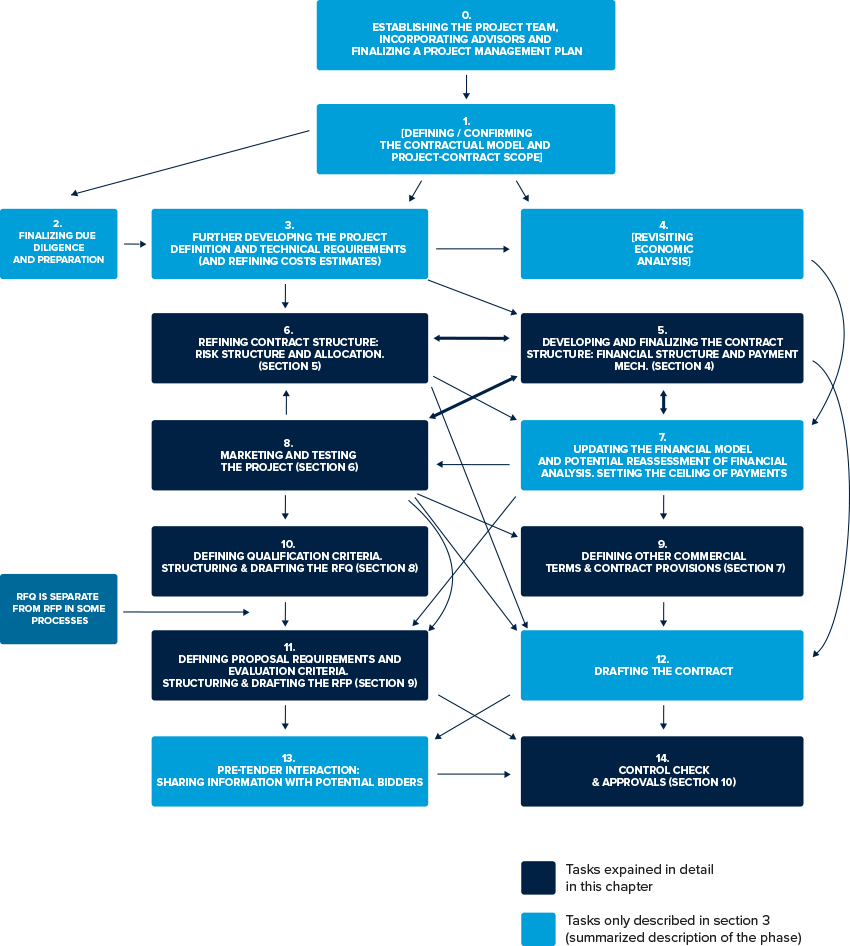4. Financial Structuring (from the Public Perspective): Defining the Financial Structure and Payment Mechanism
For the purpose of this chapter, the term financial structure is taken from the public perspective, that is, the financial structure of the contract as opposed to the financial structure of the project company (which is how the private partner would use the term). In this context, the financial structure refers to the definition of the means of public compensation or payments.
3. Summary Description of Main Tasks to be Carried Out in the Structuring Phase
3.1 Establishing the Project Team, Incorporating Advisors and Finalizing the Project Management Plan for this Phase
A realistic timescale is essential
Regardless of the envisaged order of the tasks, it is crucial to schedule and organize the work properly in advance, so as to minimize time disruptions and smooth the process. This work, like the appraisal work, is time consuming and requires a realistic time scale to ensure the required quality (see box 5.4). Structuring and drafting, as well as the whole process of the PPP, is a project in itself. As in any project management function, work organization and time scheduling are paramount factors to successfully manage the project.
2. Overview of the Structuring Phase
FIGURE 5.3: Structuring and Drafting Process

Note: RFP= request for proposal; RFQ= request for qualification.
1.2 Where We are in the Process Cycle
During the Appraisal Phase, all relevant aspects of the project were assessed for feasibility purposes, and in many countries public investment in the project would have been approved. Some feasibility exercises may be subject to confirmation during the Structuring Phase. This is especially true if further development of the project’s details and structure give the procuring authority a reason to reconsider certain aspects of the project scope and/or previously assumed features of the PPP contract structure.
1.1 Objectives of the Phase
Through a proper structuring and drafting process (of both of the contract and the RFP package), the government is aiming to ensure that the procurement of the PPP Project will be a success by launching an affordable and feasible project that will deliver the desired levels of service and a Value for Money (VfM) outcome, while reducing the risk of failure to a minimum. This can be specified as follows.
1. Objectives of this Phase and Where We are in the Project Cycle
Introduction
This chapter covers the period from the preliminary decision to invest in a PPP, once the project has been appraised, to the official launch of the tender for the project contract.
It corresponds to two main tasks and areas of knowledge.
2. Main Types of PPP Tender Processes
Open Tender or One-stage Tender Process
In this form of open tender, the RFP is published at the same time as the contract, and launching implies the invitation to propose, with the tender open for bidding to any potential bidder. The proposal requirements also include the qualification requirements. It may be structured as one single document (less desirable) or as two separate documents (the RFP and the contract).
1. Introduction to tender approaches
The procurement procedure is the process that will be followed by the government to assign the contract, and it will generally be referred to in this PPP Guide as the ‘tender process’.

